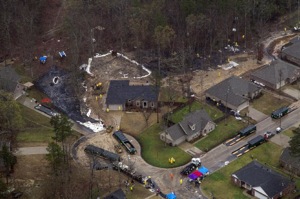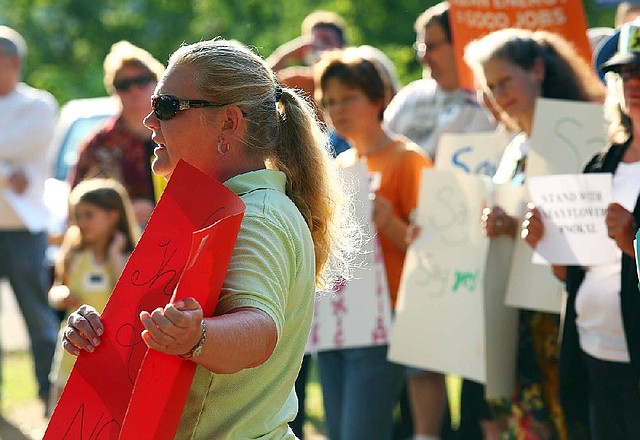No oil-spill returnees, but dead animals up
Mayflower resident Angela Harness speaks during a gathering by a group called Arkansans Concerned about Oil Pipelines Monday afternoon at Pearce Park in Mayflower. The group spoke of concerns about pipelines on the one month anniversary of an oil spill in Mayflower from an ExxonMobil pipeline.
Tuesday, April 30, 2013
MAYFLOWER - One month after an Exxon Mobil pipeline ruptured, spilling more than 200,000 gallons of oil into a Mayflower subdivision and a cove of Lake Conway, the numbers of wildlife displaced, injured or killed have significantly risen as the cleanup has increasingly focused on the backwater.

And not a single homeowner has opted to move back into any of the 22 evacuated houses despite repeated all-clear signs from Exxon Mobil Corp. and government officials at various levels for almost half of the homes. Faulkner County Judge Allen Dodson said Monday that, to his knowledge, no one wants to move back yet.
The number of animals affected since the Pegasus pipeline split open March 29 in a yard between two homes in the Northwoods subdivision reached 683 as of Sunday, Exxon Mobil Corp. spokesman Aaron Stryk said Monday. That number is almost five times greater than the 139 reported April 8, according to information obtained from the Arkansas Department of Environmental Quality.
Of the 683 creatures affected, 362 were captured, 103 were found dead and 218, all snakes, were euthanized in the field, Stryk said in an e-mail. Among captured wildlife, 203 creatures have been released, while 105 remain under care by wildlife experts. Six animals - one duck and five turtles and snakes - were euthanized at the care facility.
“The jump in numbers, particularly for those captured, is due to cleanup taking place near the shores of the cove, where a lot of small cricket frogs are being found,” Stryk said. “To avoid injury or death, they are taking the frogs from the cove to a habitat a few miles down the road to keep them out of harm’s way.” He said he had been told that workers were moving “anywhere from 20-30 [cricket] frogs” daily.
Cricket frogs, which are common in Arkansas, breed from April to July, according to the book, The Amphibians and Reptiles of Arkansas by Stanley E. Trauth, Henry W. Robison and Michael V. Plummer.
EUTHANIZED SNAKES
Snakes - some venomous - have been perhaps the most common victims of the oil spill.
Just a few days after an estimated 5,000 barrels of oil - a total of 210,000 gallons - rushed through the roughly 1-mile-long area of the spill, the Arkansas Game and Fish Commission gave the OK for cleanup crews to kill snakes they encountered for safety reasons. Because these workers generally are not veterinarians or snake experts, the form of “euthanasia” may be a shovel.
Death by shovel is an approved method of euthanasia for snakes if their heads are decapitated rapidly, said Keith Stephens, a commission spokesman, and Ben Cash, a University of Central Arkansas biology professor and reptile expert who has successfully cared for 20 snakes since the pipeline ruptured.
Cash said a more preferred method would be a chemically induced death. But he said he understands that workers in the field are dealing with immediate safety concerns and that they aren’t trained to handle the reptiles.
But Cash said he wishes Exxon Mobil had at least asked reptile experts to help with more of the snakes rather than kill so many. Once the commission gave the green light for in-the-field euthanasia, he said, he did not get any additional calls for help. And he could have taken a few more snakes. The 20 he took are all doing well, including a harmless water snake that struggled for a while, he said.
“I understand that in a sort of rapid decision-making process that they were in, that safety becomes an important thing. However, I would have liked to have seen a little more effort dealing with the snakes,” he said.
Cash is convinced that Exxon Mobil made a public-relations decision when it came to how much effort to expend on the snakes.
“These aren’t baby ducks,” he said.
“That’s just not something people are going to be shocked by,” he said, referring to a dead snake.
Some of the snakes Cash has been caring for have shed their oil-slicked skins - a good thing because that process reduces the reptiles’ contamination as well as any chemicals they might expose other creatures to, especially if they are eaten by a large hawk, for instance, Cash said.
Stephens stressed that agency officials were concerned about safety when they approved in-field euthanasia.
“I think there’s so many [snakes],” Stephens said, explaining why the agency didn’t seek more help from reptile experts. “It’s just overwhelming.”
The commission is storing all wildlife, including the snakes, known to have died because of the spill in a freezer for remediation and potential evidence, Stephens said.
Exxon Mobil spokesman Russ Roberts said Monday that the corporation appreciates “all the work that [Cash] did to assist with the response, however, Exxon Mobil never advises individuals to handle oiled wildlife during any stage of a cleanup.” He said the contractor the corporation hired, Wildlife Response Services, “ensured that impacted wildlife was properly handled.” POLITICAL IMPACT
The spill also has become a rallying point for opponents of the proposed Keystone XL pipeline, which would carry crude oil from Canada to Gulf Coast refineries at a rate of more than 800,000 barrels a day.
Early Monday evening, a small group of Keystone XL opponents, many carrying signs, gathered at a Mayflower park for what they called a “Stand With Mayflower/No to Keystone XL” event marking the one-month anniversary of the oil spill.
“This should have never happened in Mayflower, Ark.,” Glen Hooks, a Little Rock resident who is a senior campaign representative for the Sierra Club, told the gathering. “This should never happen in America.”
Imagine what would happen with a pipeline as big as the proposed Keystone XL had it ruptured in Mayflower, Hooks said.
“Remember Mayflower, and say no to Keystone XL,” he said.
In Washington, a consumer watchdog organization called SumOfUs.org, in partnership with Oil Change International and Environmental Action, said Monday that they would begin placing advertisements in the capital city’s metropolitan commuter system, with images from the Mayflower oil spill.
The ads will appear for one month at a commuter station used daily by many State Department employees, the groups said in a news release. The Keystone XL proposal is under consideration by the State Department.
RE-ENTRY PLAN
In another development Monday, the oil spill’s unified command, which includes Exxon Mobil and government agencies, issued a news release that said the group “will be initiating a re-entry plan for the evacuated residents in the Northwoods subdivision to safely return to their homes over the next few weeks.”
Officials have previously said residents of up to 10 homes have been cleared to return if they wished.
Dodson said none of the remaining 12 homeowners have been cleared for moving back yet. Because of work to replace a storm-drain pipe on Starlite Road after oil got beneath it, there’s so much equipment in the area that it probably would not be wise for residents living close by to return yet anyway, he said.
“I just don’t think it’s safe to be around that much equipment,” Dodson said.
Officials are just trying to share more information with residents about the situation, he said.
“We can’t force anyone to go into their homes,” Dodson said. “What we do is send the signal to them that it’s OK, that now we’re ready for you, [that] we feel like it’s now ready for you to begin the re-entry process, which will be a process of checking the air quality in the homes.”
Exxon Mobil has provided a compensation plan to subdivision residents. Among other things, the corporation has offered to buy the 11 houses where oil got onto the property.
Exxon Mobil is still covering the living expenses of evacuated residents, many of whom are now staying in rental homes rather than motels, Dodson said.
Ross said officials are discussing with evacuees “the beginning of preparations for the remaining” homes not already cleared for returning.
Front Section, Pages 1 on 04/30/2013
